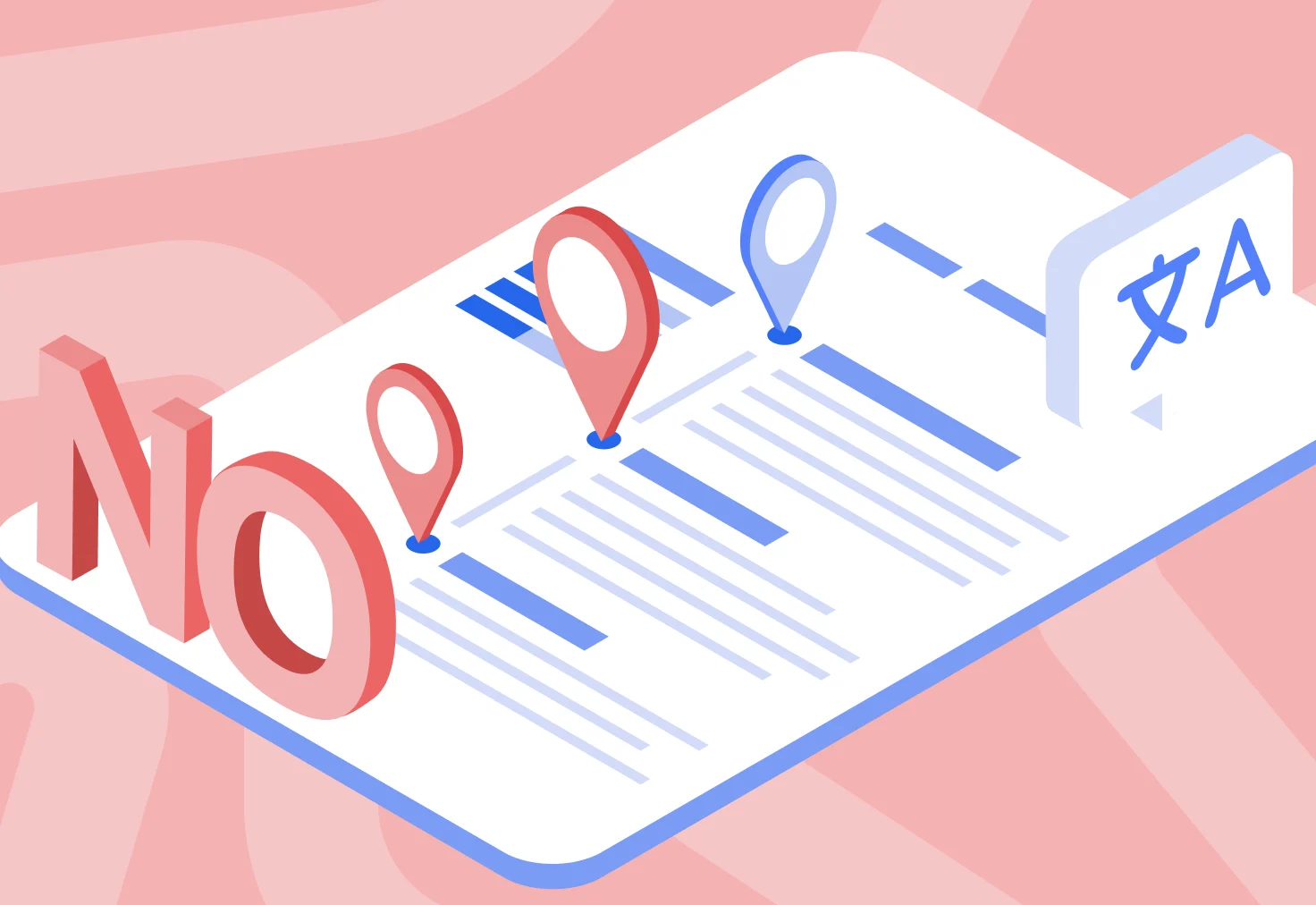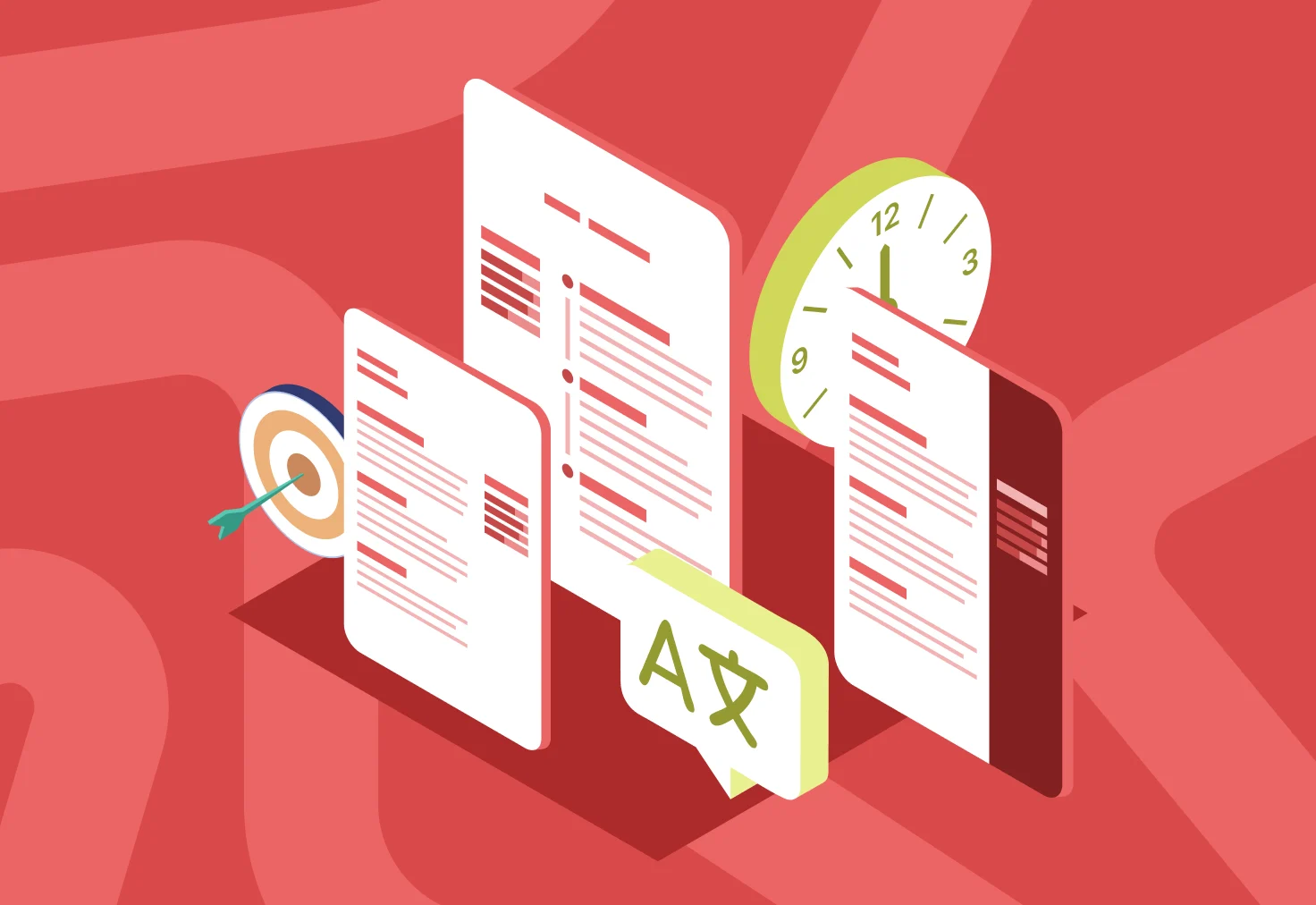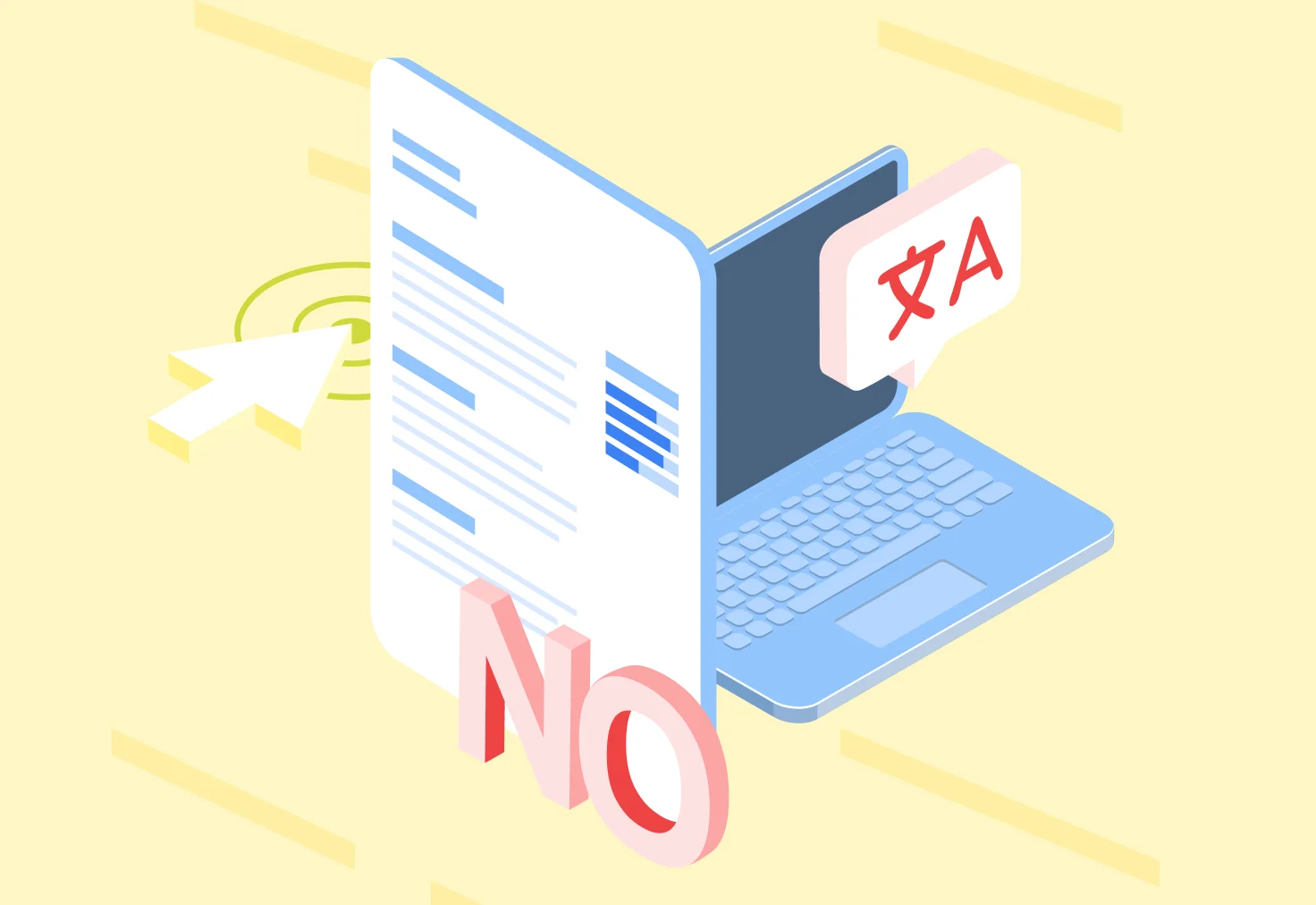ATS mistakes are inaccuracies you can have in your resume, which could harm your chances of passing the software screening.
Many companies use ATS (applicant tracking systems) to expedite hiring processes. These digital tools scan resumes and filter qualified candidates to help recruiters find new hires more efficiently.
This article explores the inner workings of applicant tracking systems to help you optimize your resume for them. You’ll learn about the critical mistakes that could result in an immediate disqualification and some actionable steps to fix your resume.
Key Takeaways
ATS systems evolved to recognize complex patterns and underlying information, helping recruiters find the best applicants for their companies.
Some of the biggest ATS mistakes include using incorrect formatting or file type, missing keywords or overusing them, being inconsistent with dating and naming resume sections, and adding important information in a header or footer.
You can test if your resume is compatible with the ATS by using online scanners, conducting a plain text test, comparing it with the job description, and getting a professional evaluation.
The simplest way to make a professional resume compatible with the ATS is to use a resume builder like Resume.co offers.
How ATS Systems Have Evolved in 2025
In 2025, ATS systems have evolved by becoming more sophisticated, capable of recognizing complex patterns and finding specific information in resumes. Initially, applicant tracking software mostly revolved around simple keyword scanning, allowing recruiters to sort through candidates based on elements like skills and job titles.
With recent technological advancements, ATS solutions have started implementing machine learning and artificial intelligence to improve their capabilities. This gave applicant tracking systems the ability to perform more delicate and nuanced analyses, find underlying patterns, and be better at discovering potential candidates.
Today, ATS systems can understand the context behind keywords. They analyze a candidate’s skills and experience while looking at the bigger picture and not just the presence of keywords in a resume. Some systems can also learn to become better at finding specific individuals who are a good fit for the organization over time, based on the company’s hiring practices.
Moreover, artificial intelligence allows the software to parse resumes and interpret the information on them with greater accuracy. For instance, it can analyze phrasing to make a distinction between candidates of similar experience. Furthermore, it can attempt to evaluate soft skills based on the rest of the content and the language used.
Modern ATS can detect hyperlinks as well, making it vital to include them properly in the document and optimize the pages they lead to. Some ATS also read photos, but most don’t, so you should add images to your resume (and definitely not a personal photo).
Here’s a brief rundown of what this all means for job seekers in the current market:
Keywords are important, but context matters just as much.
A structured document with clear and concise writing will typically outperform lengthy and complex resumes.
It’s critical to match your resume to each job you’re applying for.
7 Critical ATS Mistakes That Instantly Disqualify Your Resume

If you want to know how to avoid being rejected by ATS, here are seven critical mistakes to be aware of.
#1. Using Complex Formatting and Design Elements
Overcomplicating the structure and design of your resume is one of the biggest ATS mistakes you can make. Moreover, while intricate graphical elements and complexity might draw the attention of a human eye, they make your resume harder to read, prompting recruiters to discard it.
In the vast majority of cases, you should use one of the following three established resume formats:
Established Resume Formats
Chronological resume format focused on consistent work history
Functional resume format skills
Combination resume format that combines the elements of the previous two formats
Following that, your resume layout should be clean and elegant, with a professional font and regular size, uniform margins, and consistent line spacing. You should avoid including tables, images, and graphics, but focus on legible writing and bullet points that ATS recognizes.
#2. Submitting Incompatible File Types
The file type in which you submit your resume can mean the difference between passing the scan or having your document automatically discarded.
One of the most common file types for your resume is PDF, which is accepted by the vast majority of applicant tracking systems. It preserves the formatting of your resume and ensures it stays the same regardless of the device on which it’s viewed.
Another common option is Microsoft Word’s DOCX file type. DOCX is also considered an industry standard and will typically ensure ATS compliance.
However, some ATS tools (especially older systems) might require specific file types. That’s why it’s essential to carefully read the job ad and follow the employer’s instructions when submitting your resume.
#3. Missing Critical Keywords from the Job Description
Applicant tracking systems are set up to scan resumes for keywords present in the job description. They look for candidates whose skills and experiences closely match the company's needs.
As a result, missing these keywords in your resume will signal to the software that you likely don’t have the necessary qualifications, and your resume will be ranked poorly or rejected.
By carefully analyzing the job description and researching the company beforehand, you’ll identify the keywords you should incorporate in your resume. These are typically skills and job titles that you should integrate into the writing organically.
#4. Inconsistent Job Titles and Dates

A consistent work history is vital in a resume, especially if you’re using the chronological format. ATS looks for steady employment without significant gaps in history or overlaps due to typing errors. They can create problems when software starts calculating your years of experience.
You should use a consistent date format (e.g., ‘MM/YYYY’ or ‘Month, YYYY’) throughout the resume.
It’s also important to use industry-standard language when adding your past job titles. It’s always better to use established titles, like “Sales Associate” or “Marketing Specialist,” rather than unusual phrases, like “Sales Guru” and “Marketing Ninja.”
#5. Using Headers and Footers for Important Information
All the important information for your job application should be in the main body of your resume.
For instance, while contact information is a standard section for a resume header, some job seekers make an ATS mistake of putting it in the margins of the header or footer. As a result, critical details like their name, email address, phone number, and LinkedIn profile might not be registered at all.
In general, everything should go in the body of the document, following an established order, like:
What to Include in the Body of Your Resume
Contact information
Resume summary or objective
Work experience
Education
Skills
Optional sections
#6. Over-Optimizing with Keyword Stuffing
While not including relevant keywords in your resume is a significant ATS mistake, overstuffing the document with them can be just as bad. “Keyword stuffing” is an outdated practice (primarily in SEO and marketing) that makes your resume look unnatural and suspicious to both software and recruiters.
Instead, you should strike a balance between including all the relevant keywords without going overboard. That means not just adding them whenever possible, but integrating them into your writing naturally while keeping an eye on the overall context.
#7. Failing to Use Standard Section Headings
Applicant tracking systems are programmed to look for standard section headings and analyze the information within those sections. Using headings like “Work Experience,” “Skills“, and Education” ensures the software recognizes the wording and correctly parses the contents within.
You should avoid being too creative with the names and using unconventional phrases, like “My Journey So Far” or “What I Bring to the Table.” While that might seem like an innovative way of grabbing the reader’s attention, it will more likely leave you asking, “Why can’t ATS read my resume?”
5 Ways to Test If Your Resume Is ATS-Friendly

Even if you’ve avoided making all the big ATS mistakes, you should still test whether your resume is ATS-friendly before submitting it. Let’s find out how you can do that.
#1. Using ATS Simulator Tools
There are many online ATS simulator tools (also referred to as ATS checkers or scanners) that can analyze your resume. You can upload the document once you’ve created it, and the software will let you know if it passes the scan or if there are some issues you should address.
ATS simulators can give you valuable feedback, like whether you need to increase or reduce keyword density, if there are some problems with the formatting, if you need to improve your design, enhance readability, and so on.
In general, you should also upload a job description with your resume. The tool will then be able to compare the two and give you a match score, suggest areas of improvement or the keywords you should add, and more.
#2. The Plain Text Test
The plain text test allows you to check if your resume looks good without any formatting. It’s a simple but effective method that you can use without any specialized tools or software.
Here’s a quick step-by-step guide:
Open your resume in the word processing software in which you created it.
Save your resume as plain text (e.g., in a .txt document).
Open the .txt file and review the contents of your resume.
You want to verify that your resume looks good while in plain text. This includes checking if all the information is still there, if the order remains consistent, or if everything is jumbled up, if special characters haven’t been changed completely, etc.
If your resume is messy in plain text, it might run into issues with the ATS.
#3. Comparison With the Job Description
While ATS simulator tools can compare your resume with the job description, it’s imperative you conduct a manual check as well. Software, while sophisticated, can still overlook some small details that could have a big impact on both ATS and recruiters.
That’s why you should meticulously read the job description while paying close attention to the skills and qualifications required. You can extract further insight from the description of the responsibilities or the language used.
You should match the language of the job description and ensure your resume presents you as someone capable of effortlessly fulfilling the presented responsibilities.
#4. Professional Resume Evaluation
Getting a professional resume evaluation is one of the best methods not just to avoid ATS mistakes but also to maximize your chances of impressing recruiters and getting an interview invite.
If you have the time and resources, you should consider asking a professional resume writer or career coach for assistance and feedback. They can analyze your resume and job description to give you specialized advice based on your industry, experience level, and career goals.
Moreover, a fresh pair of eyes can discover even simple mistakes, such as grammar issues or typographic errors. They can also explain what recruiters will focus on in your resume and how to discuss it during your job interview.
#5. Use an ATS-Friendly Online Resume Builder
Many online resume builders are designed to produce ATS-friendly documents. They often come with premade templates and examples of ATS-compatible resumes you can use for inspiration.
These tools will ensure industry-standard formatting accepted by applicant tracking systems, feature the best fonts for resumes, incorporate clean section headings, and more. Most of the online resume builders (including our own at Resume.co) also have ATS-specific templates and features designed to help job seekers pass even the most demanding systems.
Ultimately, using online resume builders significantly simplifies the creation process. It not only ensures a resume meets ATS requirements, but it also helps professionals save time and effort, allowing them to craft professional documents in minutes.
How to Fix Common ATS Problems

Now that you’re familiar with the biggest mistakes you can make, here are some simple ATS tips and tricks to help you fix the most common problems quickly and effortlessly:
Fix ATS Problems
Simplify the layout. Remove complex elements, like tables, text boxes, and graphics. In most cases, you should use a single-column layout with bullet points for achievements and work-related results.
Use standard fonts. Common choices include readable fonts like Arial or Times New Roman. Font size should be 10–12 pt for regular text and 14–16 pt for section headings.
Verify heading names. Make sure to use established headings, like “Work Experience” and “Education.”
Submit the accepted file type. Save your resume as a PDF or DOCX unless the job posting has a different requirement.
Use a consistent date format. One of the best options is MM/YYYY for all past jobs and education.
Include relevant keywords. Incorporate all the important keywords you find in the job posting organically throughout your resume.
Here’s a brief example of a work experience section before and after removing ATS mistakes, starting with before:
Before Removing Mistakes
My Journey So Far
Marketing Sage
Ad Agency Chicago, IL
September ‘23–2025
Ran ad campaigns.
Now, here’s what this section should look like after we’ve implemented the fixes to optimize it for ATS:
After Implementing the Fixes
Work Experience
Marketing Specialist
Ad Agency Chicago, IL
September 2023–March 2025
Launched and managed an e-commerce ad campaign that resulted in $4.5M in revenue for the client.
Create an ATS-Friendly Resume with Resume.co

The simplest way to ensure ATS compatibility while creating a professional document is by using our resume builder. We developed a tailored solution for job seekers to streamline the process of designing and writing a resume by incorporating ready-made templates and user-friendly customization options.
Our builder offers a range of clean, elegant, and ATS-friendly resume templates created by industry experts and HR professionals. The templates are preformatted and have all the mandatory sections included and named appropriately, so all you need to do is input your details in the blank spaces.
Even then, our AI-powered assistant will help you polish your writing to match the needs of even the most demanding applicant tracking systems. Artificial intelligence automatically adjusts the tone and language based on your details and job title, creating a coherent resume with a logical flow for both a human reader and parsing software.
Once you’ve finished writing, you can also adjust the design of your resume without risking ATS mistakes. Change style, layout, font, and color with a single click and watch how the whole resume transforms instantly.
On top of that, our builder features a robust checklist to help ensure that you’ve made a 100% ATS-friendly resume. It continuously scans your document and suggests changes until you’ve reached the highest compatibility score.
Ready to create an ATS-friendly resume without the guesswork?
Use our builder now!Final Thoughts
If your resume features some of the critical ATS mistakes, it can get rejected before a recruiter even takes a look at it. As a result, optimizing for applicant tracking systems isn’t optional and a way to get ahead of the competition, but a mandatory process if you’re serious about landing a role.
By paying close attention to the structure of your resume, its formatting, and design, and by incorporating relevant keywords in a natural manner, you’ll significantly boost your chances of passing the scan. And if you want to simplify the process and maximize your chances of success, leverage our resume builder and create an ATS-friendly document in no time!
Related Articles
9+ Resume Mistakes to Avoid Making (According to Recruiters)
14 Best AI Resume Builders: Your Job Hunt Just Got Easier
435+ Resume Action Verbs, Power Words, Adjectives, Buzzwords


